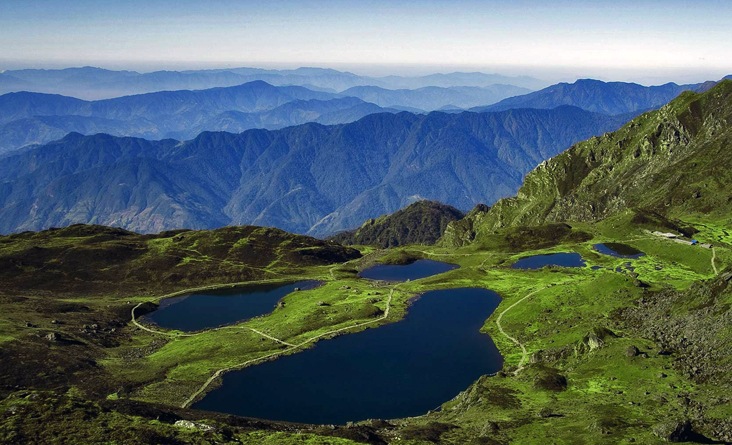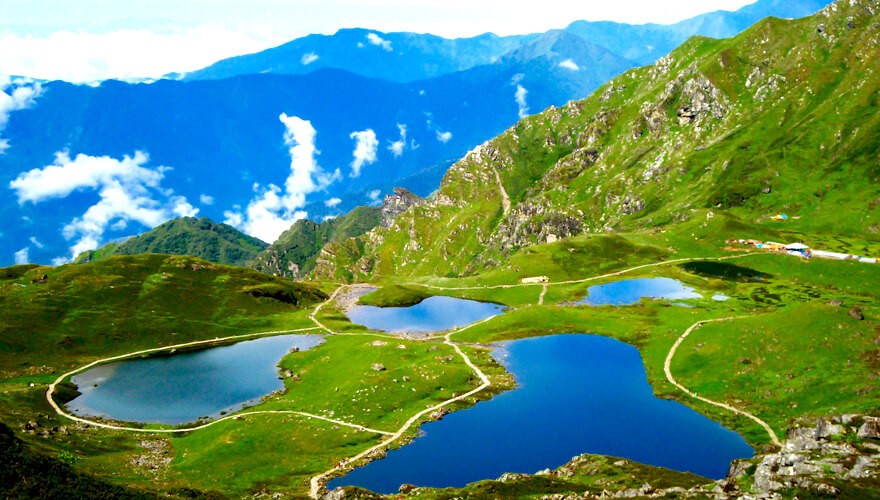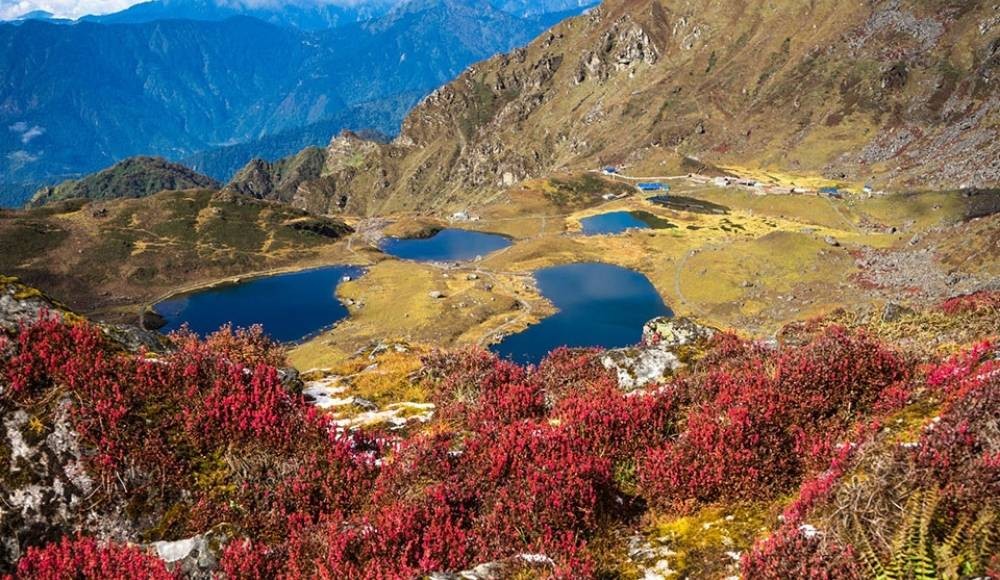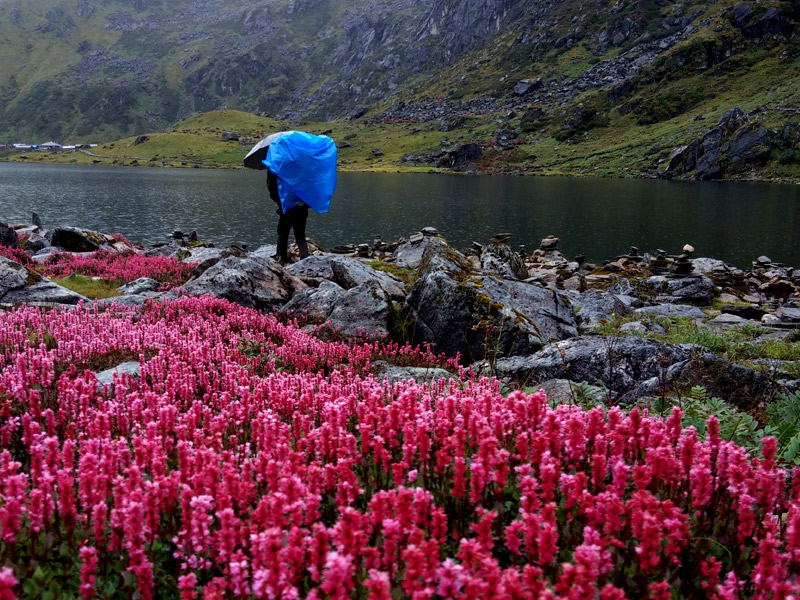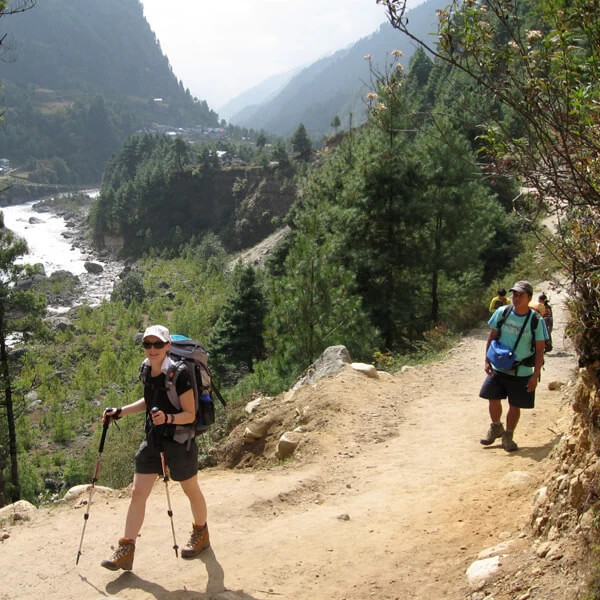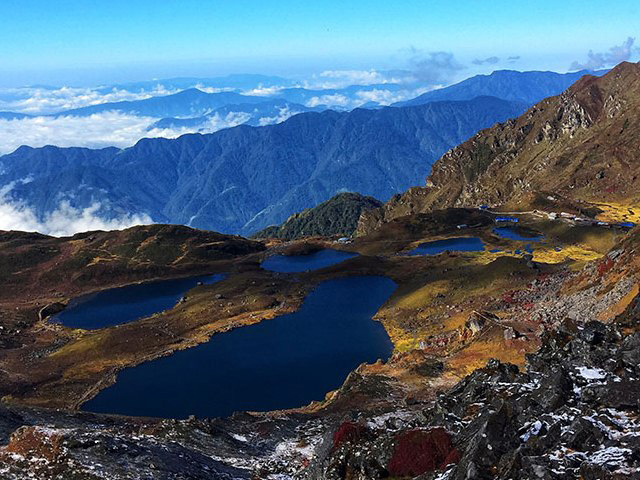Panch Pokhari Trekking
Trip Overview
Overview
The Panch Pokhari Trekking is a mesmerizing journey through the pristine wilderness of the Langtang region in Nepal. Spanning an elevation from 1,400 to 4,100 meters, this trek offers a unique blend of nature, culture, and adventure. "Panch Pokhari" translates to "Five Lakes" in Nepali, and these holy lakes hold religious significance for both Hindus and Buddhists. The trek begins with a scenic drive from Kathmandu to the trailhead at Chautara, which serves as the gateway to the trekking route. As you ascend through lush forests, quaint villages, and terraced farmlands, you'll also get treatment from breathtaking views of the Langtang and Jugal Himalayan ranges. The cultural aspect of the journey shines through encounters with local ethnic communities like Tamangs, Sherpas, and Gurungs, allowing you to witness their traditions, hospitality, and daily lives. Tea houses along the route also provide cozy accommodation and warm meals, creating an authentic experience of rural Nepali living. The highlight of the Panch Pokhari Trek is reaching the five sacred lakes, nestled amidst the towering mountains. The lakes, with their crystal-clear waters reflecting the surrounding peaks, exude a serene and spiritual atmosphere. Many trekkers choose to visit during Janai Purnima, a festival in August, when pilgrims from different regions congregate to pay homage to the deities and take a holy dip in the lakes. Besides the religious significance, the trek rewards adventurers with diverse flora and fauna, including rhododendron forests, rare orchids, and various Himalayan wildlife like the red panda and snow leopard (rarely spotted).Conclusion and Summary
The journey concludes with a descent back to Chautara, where you can enjoy a well-deserved rest and reflect on the unforgettable experiences of the trek. Panch Pokhari Trekking is a relatively less-crowded route, making it an ideal choice for trekkers seeking tranquility, natural beauty, cultural insights, and a sense of spiritual connection with the Himalayas. Overall, this 10 to 12-day trek promises to be a soul-stirring adventure for nature enthusiasts, photographers, and anyone seeking an off-the-beaten-path trekking experience in Nepal.Trip Highlight
- Different species of birds and wildflowers during the trek.
- Five sacred ponds at an altitude of 4100 Meters above sea level.
- Discover different valleys, glaciers, lakes, waterfalls, etc.
- A stunning sunrise from 4100 meters above sea level.
- Experience Tamang culture and traditional architecture of Tamang villages.
- Famous for Musk deer, Himalayan Black bear, Himalayan wild goat, etc.
- Explore the colorful Rhododendron forest with some of the tallest mountains.
Itinerary
At 09:00 AM: Have your breakfast and be ready for today’s guided Kathmandu cultural sightseeing. You will be exploring some of the UNESCO-listed world heritage sites of Nepal, located within the Kathmandu valley.
At. 09:30 AM: Visit Pashupatinath temple.
At.11:30 AM: Visit the Boudhanath stupa, you can have your lunch around the Boudhanath, there are several local and continental restaurants and cafes within the Boudhanath square along with the stupa view from the rooftop.
At. 02:00 PM: Visit Swayambhunath Stupa.
At. 04:00 PM: At the end, visit Kathmandu Durbar Square, the famous local market area of the old Kathmandu.
At. 06:00 PM: You will be dropped back at your hotel.
Besides sightseeing, you can do the required shopping for your trek if needed.
At 07:00 AM: After breakfast, you will drive towards Melamchi Bazar via Jarsing Pauwa. You will have lunch there and you will continue your drive to Thulo Bhotang which will take around 3 hours and covers a distance of about 75km. Throughout this route, you can see unique and beautiful Tamang villages & settlements and take a taste of their unique culture. After reaching Thulo Bhotang, you will trek to Chimti village. Overnight stay at the hotel.
At. 08:00 AM: On this day, you will continue your trek towards Taapkharka which will take around 5-6 hours to walk. It is going to be a trek that covers deep forests and a difficult trail. You can also witness leeches along the trail. Overnight stay at tented camps.
At. 08:00 AM: The trek continues from Taapkharka to Nasimpati. It will take around 3-4 hours to reach Nasimpati. Along the trail, you can witness the magnificent views of Panchpokhari as well as you can spectate the beautiful Langtang mountain ranges as well as the Helambu range. This day is not going to be as strenuous as the previous one as the jungle ends here giving way to small bushes and shrubs. Overnight stay at tented camps.
At. 08:00 AM: It is the day when you will be trekking towards the Panch Pokhari which is a beautiful, subtle and holy pilgrimage site and a wonderful destination to visit. The trail to Panch Pokhari is a semi-strenuous hike that covers a duration of about 3-4 hours and a distance of about 5km. Panchpokhari is an everlasting sight for the sore eyes and you can also witness a Hindu temple nearby dedicated to Lord Mahadev. Panch Pokhari is also the 9th altitude wetland in the world. Overnight stay at tented camps.
At. 05:30 AM: Early in the morning, you will be hiking to the highest point of the trek which will be a stress reliever for you. From the highest point, you will be getting phenomenal and astounding views of the Yangri, Jugal Himal, Dorje Lakpa, Gaurishankar, and Langtang Himalayan ranges. It will be wonderful scenery to cherish. After that, you will return to Panch Pokhari, have lunch, and trek towards Nasimpati which will cover a duration of about 3-4 hours. You will return spectacular views all the way. Overnight stay at tented camps
At. 08:00 AM: You will continue your trek towards Tembathang which will take about 6 hours from Nasimpati and covers a distance of about 13km. Upon reaching Tembathang, you can observe the beautiful Sherpa settlements and culture. Overnight stay at tented camps.
At 08:00 AM: This day, you will be trekking towards the Gumbathang which will take about 5-6 hours to reach and covers a distance of about 11km. Upon reaching this village, you will find the opportunity to observe the Tamang cultures and traditions and the nature of settlements. Overnight stay at tented camps as well as homestay.
At 08:00 AM: This morning, you will head towards Pangtang village which will take around 6-7 hours and covers a distance of about 10km. You can observe the Newar and Tamang communities living side by side and maintaining religious and cultural integrity and harmony. You will have an amazing experience. Overnight stay at tented camps as well as homestay.
At. 08:00 AM: On this day, you will trek to Chanaute which will take around 3-4 hours and covers a distance of about 13km. Upon reaching there, you will drive back to Kathmandu. Along the trail, you can get mesmerized by the magnificent views of the mountains surrounding all around, lush forests, the sound of the free-flowing rivers, and a peaceful and serene environment.
Along the trail of Panch Pokhari, you can also observe beautiful floras, faunas, and other endangered species such as Red Panda, altitude tiger, wild boar, danfe, munal, and many more which will make your trek a memorable and acknowledging one.
You can do some last-minute shopping for souvenirs for your family and relatives. After reaching Kathmandu, we will have a farewell dinner in the evening.
Have a safe home return!, You will have leisure time in Kathmandu after breakfast at your hotel. Our office representative will escort you to the Kathmandu airport 3 hours before on time to board your flight. It may take 30 minutes to reach the airport from the hotel.
Departures & Availability
The set departure dates listed are specially quoted and specified for group joining option. Let us know if the set departure dates are not suitable for you- another dates which are suitable for you can certainly be added by us.
Check Available Dates
| Start Date | Price | Availability |
|---|
All trip prices are per person based on double occupancy, are subject to change without notice and do not include airfare. All prices and fares are quoted in U.S. dollars.
Price include
- All arrival and departure at Kathmandu airport as mentioned.
- Private transfer (Kathmandu/Chautara/Kathmandu) as mentioned in the itinerary.
- Hotel accommodation (3 Star Deluxe) in Kathmandu on double/twin sharing basis.
- Tea house/local lodge accommodation during the trek on double/twin sharing basis.
- Daily breakfast throughout the trek.
- Lunch and Dinner from trek start day to trek end day.
- All necessary paperwork. (National Park Entry Permits and TIMS Card)
- An experienced English-speaking licensed trek guide.
- Porter during the trek. (Can carry a combined 20 KG baggage of 2 people)
- One local SIM card (returnable) during your stay.
- All government and local taxes.
- Guide and Porter’s salary, food, and accommodation during the trek.
- Arrangement of emergency helicopter service which will be paid by your traveler’s insurance company.
- Sleeping bag, duffle bags, and trekking route maps – if necessary.
- Farewell Nepali dinner on your last night.
Price Excludes
- Personal expenses.
- Kathmandu sightseeing entrance fee. (Approx. USD 40 Per Person)
- Lunch and dinner in Kathmandu.
- Nepal visa cost. (You will require 2 passport-size photos and 30 USD)
- International flight ticket.
- Travel health insurance. (Highly Recommended)
- Tips for the guide, porter, and driver. (Not Compulsory but Recommended)
- Sweet things like dessert/chocolate during the trek.
- All alcoholic and non-alcoholic drinks.
Gears And Equipment
Trip Information
Major Attractions of Panch Pokhari Trek:
Panch Pokhari trek encompasses you with the beautiful delicacy of nature where you will get to explore the untouched beauty of nature. Panch Pokhari trek route is a less frequented route that is far from the hustle and bustle of the cityscapes and will engage you with the dramatic and pristine beauty of nature and will provide you with an adventurous memory for a lifetime.
Panch Pokhari:
Panch Pokhari is a fantastic location made up of five gorgeous lakes. The Indravati River is thought to have its beginnings in the lakes. The Panch Pokhari Mahatmyam, Skanda Purana, and Himwat Khand all refer to Panch Pokhari’s significance. It claims that Tirthraj Prayag and Badganga Kurukshetra’s pilgrimage sites, as well as the Bhairav Kunda, Saraswati Kunda, Surya Kunda, and Nag Kunda, are of equal importance.
Additionally, you can enjoy the expansive grandeur of the mountain range and a wide variety of flora and fauna. This location has amazing views of the sky, the mountains, the lake with its sparkling sapphire, and the vivid, colorful mountains. The nicest thing to see at this mind-blowing location in Nepal is a succession of clouds concealing the alluring snow-capped hills around the five transparent, clean lakes.
Mountain Ranges:
Besides the pristine and gorgeous five lakes of Panch Pokhari, you can witness the majestic views of the beautiful Himalayan ranges along the trails of the Panch Pokhari trek. You can get a mesmerizing view of the glorious mountain ranges around the routes of Panch Pokhari. You can get hold of the awe-inspiring views of the majestic vistas of the mountains such as Gauri Shankar Himal, Dorje Lakpa, Jugal Himalayan Range, Rolwaling Himalayan Range, Madiya, Phurbi Chhyachu as well as other eye-strucking ranges.
Best time to visit the Panch Pokhari Trek:
Since Panch Pokhari is one of Nepal’s less used trekking routes, it is a tranquil and serene trek. The Panch Pokhari walk is one of the most beautiful treks that one should take while visiting Nepal because its nature is unspoiled and not harmed by unruly human settlements.
Moreover, the best seasons for attaining the Panch Pokhari trek are the autumn and spring seasons. The Spring season falls in the months of March, April, and May whereas the autumn season falls in the months of September, October, and November. Trekking the beautiful Panch Pokhari in these respective months will allow you to fully embrace the beauty of the lake as these seasons contain a moderate amount of sunshine and a low amount of precipitation which will make your trek not very difficult but an enthralling and memorable one. During the Spring and Autumn seasons, the weather is pleasant and stable. So, visiting this time has better chances to make the experience better. Likewise, trekking Panch Pokhari in these seasons will allow you to witness the clear views of the serene mountains and the peaceful and gorgeous nature.
It is not that it is impossible to complete the trek in the winter and summer seasons. You can complete the trek in the winter season (December, January, and February), but you need to take in mind the cold and harsh weather you are going to witness during this season and carry the appropriate and essential gear needed. With appropriate gear and planning, you can complete the Panch Pokhari trek in the summer season too which falls in the months of June, July, and August.
Panch Pokhari Trek Difficulty:
The moderately challenging Panch Pokhari trek is located in the Langtang valley and Helambu area. This region is little explored and frequently visited. Therefore, traveling to this area is worthwhile in terms of the experiences you can have. It is difficult to find appropriate lodging facilities in this area because it is desolate. In the lower areas, there are a few teahouses. However, in the upper altitudes, you might have to camp. The most lovely aspect of trekking is getting to experience Nepal’s stunning rural and secluded scenery.
This trekking region is located at a height of above 4000 meters. As a result, having high altitude sickness is possible. The risk of severe altitude sickness, which could eventually lead to HAPE (High Altitude Pulmonary Edema) and HACE, can be reduced with the use of appropriate medicine and other measures (High Altitude Cerebral Edema). As a result, it’s crucial to drink enough water, eat a balanced meal, and, if altitude sickness persists, take the appropriate medications and undergo acclimatization.
Relating to the topic of the difficulty of the Panch Pokhari trek, we can conclude that this trek is not a very difficult trek. It is a moderate trek. One can complete this trek by applying a little effort and perseverance. An average healthy person can accomplish this trek without any such adverse difficulties and problems.
One of the things you should keep in mind is the packing list. You should not carry excess baggage which can lead to excess strain on your body. Necessary amenities should only be carried. For the packing list suggestions, you can visit the Nepal trekking gear checklist.
Trekking in this area is not advised during the winter or summer. Trekking in the rainy and summer months puts you in danger of natural disasters. The mountainous terrain is vulnerable to avalanches and landslides during the monsoon season. Therefore, it is preferable to avoid it. You won’t enjoy the leeches and earthworms on the trails, either. Mountain places are unfavorable to visit in the summer due to the erratic weather and climatic conditions.
It’s a great idea to travel during the winter. However, the upper heights’ snowfall, icy cold, and little open sky make it rather undesirable. Additionally, there is a danger of getting off the trekking path if it is dark and snowy outside. This might seem harsh. Trekking should therefore be avoided in the monsoon and winter months.
How to reach Panch Pokhari?
After a drive from the Kathmandu valley, the Panch Pokhari trek begins in the town of Chautara. You can reach Sano Okhareni by making a slow upward trek. The stunning ethnic communities, simple country life, and majestic mountains will make you feel fantastic. The following track will then lead you to Thulo Okhareni. It’s fantastic to climb more steeply while passing through pine and rhododendron forests. Gaurishankar, Dorje Lakpa, and the Jugal Himal range offer stunning and breathtaking vistas. You can reach Kami Kharka by way of the trail.
Continue on the trail, and a leisurely stroll over hills and forested areas will lead you to the stunning Pawa Bas. You must hike farther to reach Hile Bhanjyang from Pauwa Bas. You will continue your journey to Narsim Pati through a verdant forest with stunning views of the Gauri Shankar and Jugal Himal ranges. You may also come across mountain Deer and Danfe along the way (Lophophorus).
Arriving at Narsim Pati, from where you can trek to Panch Pokhari, brings the trek closer. In addition, it is a great, naturally rich location and a place of pilgrimage. Camping is beautiful when you have a view of the mountains and lakes. Beautiful sunrises over the mountains are fantastic. Panoramic views of Mt. Dorje Lakpa, the Jugal Himal Range, the Rolwaling Range, and the Langtang Valley Range are seen from Panch Pokhari. You will hike to Tupi Danda following your visit to Panch Pokhari. You can continue your journey by hiking to Dhap and Melamchi, where you can complete your walk and catch a ride back to the Kathmandu Valley.
What to expect from the Panch Pokhari trek?
Panch Pokhari trek will be an amazing and once-in-a-lifetime opportunity for you to explore one of the less discovered but one of the most beautiful treks of Nepal. Panch Pokhari trek will provide you with the serene views of the beautiful nature that you could ever ask for. Ranging from the beautiful landscapes to observing the tranquil views of the majestic mountains like Gaurishanker, Jugal Himal, Rolwaling Himalayan range, and many more, the Panch Pokhari trek will amaze you in every way possible and you will have different beautiful memories encaptured through this marvelous Panch Pokhari trek. Ranging from the unique and exotic floras and faunas and also getting to observe the pristine 5 lakes, the Panch Pokhari trek will provide you with a lifetime opportunity
Panch Pokhari Trekking Route Map
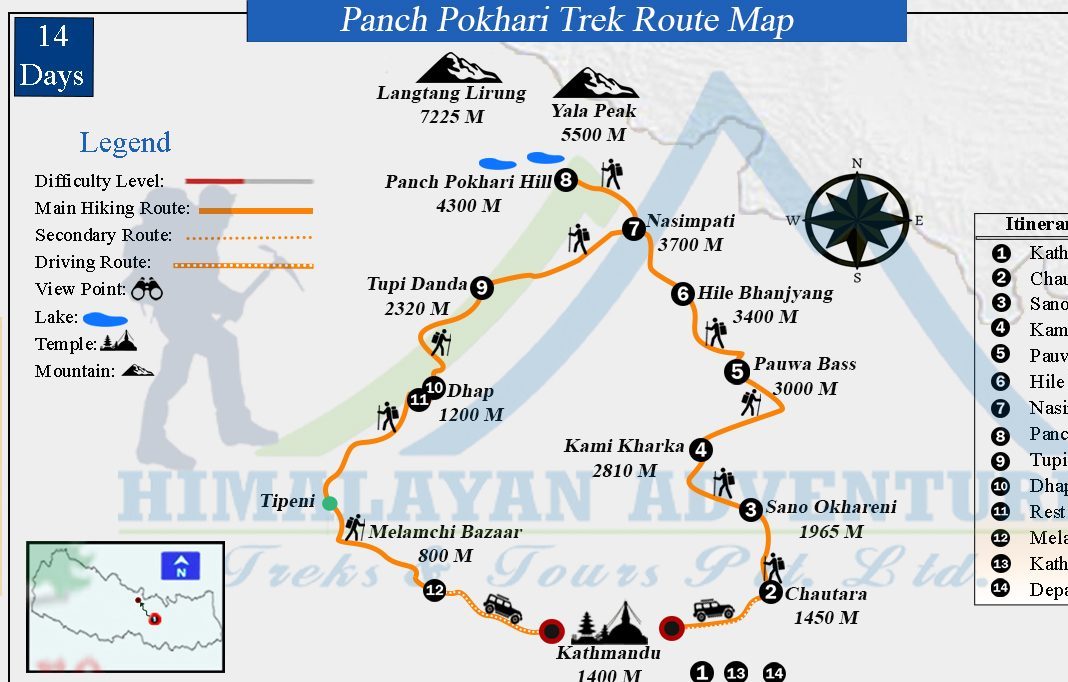
FAQS
Lorem Ipsum is simply dummy text of the printing and typesetting industry. Lorem Ipsum has been the industry’s standard dummy text ever since the 1500s, when an unknown printer took a galley of type and scrambled it to make a type specimen book. It has survived not only five centuries, but also the leap into electronic typesetting, remaining essentially unchanged. It was popularised in the 1960s with the release of Letraset sheets containing Lorem Ipsum passages, and more recently with desktop publishing software like Aldus PageMaker including versions of Lorem Ipsum.
Lorem Ipsum is simply dummy text of the printing and typesetting industry. Lorem Ipsum has been the industry’s standard dummy text ever since the 1500s, when an unknown printer took a galley of type and scrambled it to make a type specimen book. It has survived not only five centuries, but also the leap into electronic typesetting, remaining essentially unchanged. It was popularised in the 1960s with the release of Letraset sheets containing Lorem Ipsum passages, and more recently with desktop publishing software like Aldus PageMaker including versions of Lorem Ipsum.
Traveler Reviews
These full and frank reviews are from travelers who have traveled with Ace the Himalaya previously. The reviews and experiences shown here are from reputable travel websites like TripAdvisor, Google, Facebook, and Trust Pilot, etc.
